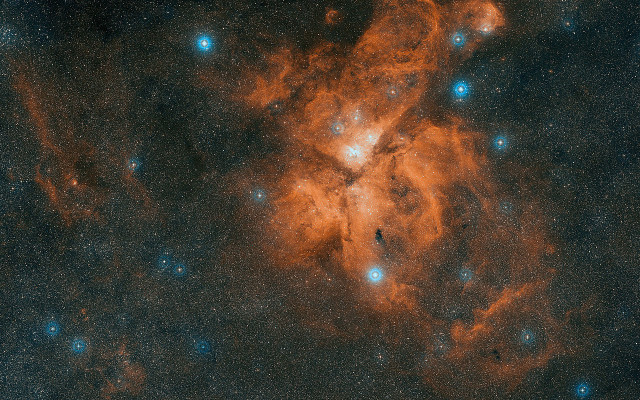Eta Carinae is one of the most massive binary star systems known, lying at a distance of about 7,500 light years from Earth. It is located in the direction of Carina constellation. The primary component in the system has about 90 times the mass of the Sun and is 5 million times more luminous.
The less massive star has about 30 solar masses and may be up to a million times more luminous than the Sun. Both stars will reach the end of their life cycles in supernova or hypernova events in the relatively near future.
The Eta Carinae system has at least two stars. The primary star is classified as a luminous blue variable (LBV). The secondary component is a hot supergiant orbiting the primary star. The companion is completely invisible in optical wavelengths because it is enveloped in the thick nebula around Eta Carinae.
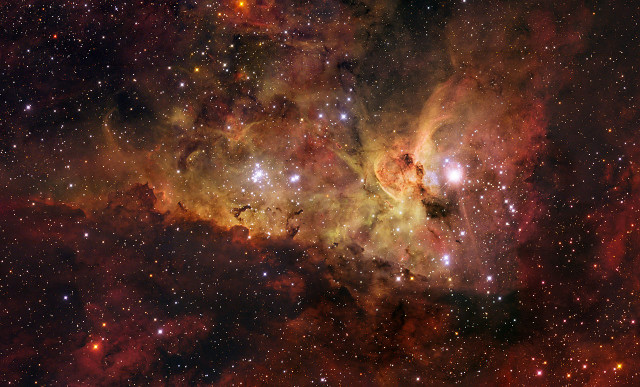
The Carina Nebula is a large bright nebula that surrounds several clusters of stars. It contains two of the most massive and luminous stars in our Milky Way galaxy, Eta Carinae and HD 93129A. Located 7500 light years away, the nebula itself spans some 260 light years across, about 7 times the size of the Orion Nebula, and is shown in all its glory in this mosaic. It is based on images collected with the 1.5-m Danish telescope at ESO’s La Silla Observatory. Being brighter than one million Suns, Eta Carinae (the brightest star in this image) is the most luminous star known in the Galaxy, and has most likely a mass over 100 times that of the Sun. It is the closest example of a luminous blue variable, the last phase in the life of a very massive star before it goes out in a fiery supernova. Eta Carinae is surrounded by an expanding bipolar cloud of dust and gas known as the Homunculus (little man in Latin), which astronomers believe was expelled from the star during a great outburst seen in 1843. Image: ESO/IDA/Danish 1.5 m/R.Gendler, J-E. Ovaldsen, C. Thöne, and C. Feron.
The star’s name is pronounced [ˈiːtə kəˈrinə].
The reflection nebula surrounding Eta Carinae is known as the Homunculus Nebula and is part of the larger Carina Nebula. The Homunculus Nebula formed after the star’s supernova impostor event in the mid-19th century. The nebula consists mainly of dust which condensed from the material ejected from the star during the outburst seen in 1843. The Homunculus Nebula is known for its appearance, with two polar lobes and an equatorial ‘skirt,’ or large thin equatorial disk.
The combined bolometric luminosity of the Eta Carinae system is more than 5 million times that of the Sun. During the 19th century outburst, the star threw off over 10 solar masses into space, which now form the surrounding nebula. The star itself, however, somehow survived the event, even though it released about as much visible light as a real supernova would.
Eta Carinae can’t be seen north of latitude 30°N and it never sets below the horizon for observers south of latitude 30°S, where it is circumpolar.
Astronomers recently developed a 3D model of the large cloud expelled by the star during its outburst in the 19th century, known as the Great Eruption. In the period between 1838 and 1845, Eta Carinae displayed unusual variability, briefly outshining Canopus, the second brightest star in the sky, also located in Carina constellation.
The star expelled a gaseous shell with a mass between 10 and 40 times that of the Sun, into space. This shell, now roughly a light year in length, forms the famous twin-lobed Homunculus Nebula. The cloud is expanding at a speed of more than 1.3 million miles, or 2.1 million kilometres per hour.
The international team of researchers used the Very Large Telescope and its spectrograph at the European Southern Observatory in Chile, and created the most complete spectral map of the nebula to date. They imaged near-infrared, ultraviolet and visible wavelengths along 92 separate swaths across the cloud, and used the spatial and velocity data to make the first high-resolution 3D model of the nebula.
“For the first time, we see evidence suggesting that intense interactions between the stars in the central binary played a significant role in sculpting the nebula we see today,” said Thomas Madura, a NASA Postdoctoral Program fellow at NASA’s Goddard Space Flight Center in Greenbelt, Maryland, and one of the researchers.
The 3D model confirms several features of the Homunculus Nebula that were already identified in earlier studies, including large holes at the end of each lobe. The model has alo helped identify new features of the nebula, including large, deep trenches around each lobe, irregular divots on the side facing away from Earth, and arm-like protrusions from each lobe near the dust skirt that can be seen near the nebula’s centre in visible light.
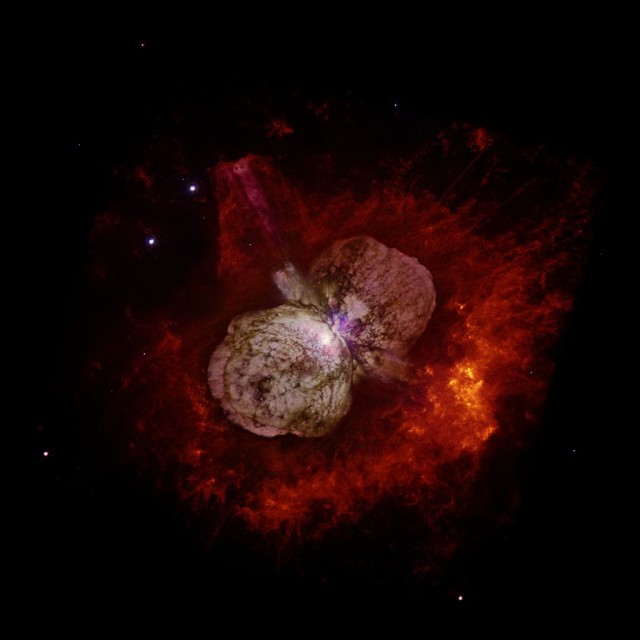
A huge, billowing pair of gas and dust clouds are captured in this stunning NASA Hubble Space Telescope image of the supermassive star Eta Carinae. Eta Carinae was observed by Hubble in September 1995 with the Wide Field and Planetary Camera 2 (WFPC2). Images taken through red and near-ultraviolet filters were subsequently combined to produce the color image shown. A sequence of eight exposures was necessary to cover the object’s huge dynamic range: the outer ejecta blobs are 100,000 times fainter than the brilliant central star. Eta Carinae underwent a giant outburst about 160 years ago, when it became one of the brightest stars in the southern sky. Though the star released as much visible light as a supernova, it survived the outburst. The event produced two lobes and a large, thin equatorial disk, all moving outward at about 1 million kilometers per hour. Image: Nathan Smith (University of California, Berkeley), and NASA
Jose Groh, an astronomer at Geneva University in Switzerland, said, “One of the questions we set out to answer with this study is whether the Homunculus contains any imprint of the star’s binary nature, since previous efforts to explain its shape have assumed that both lobes were more or less identical and symmetric around their long axis. The new features strongly suggest that interactions between Eta Carinae’s stars helped mold the Homunculus.”
The two stars in the Eta Carinae system come to their closest approach every 5.5 years, when they are roughly at a distance similar to that between Mars and the Sun. Their stellar winds interact even more dramatically during this period (called periastron) and the faster wind, emanating from the smaller star in the binary sytem, carves a tunnel through the denser wind of the larger star. The opening angle of the cavity produced by the interaction closely matches the angle between the arm-like protrusions (110 degrees) and the length of the deep trenches around the lobes (130 degress). This finding indicates that the nebula likely still carries an impression from the period around the time of the Great Eruption, when the two stars came to their closest approach.
The 3D model of the Homunculus Nebula has been converted to a format that can be used by 3-D printers, and is available to anyone with access to a 3-D printer, along with the published study.
Theodore Gull, Goddard astrophysicist and co-author of the paper, said, “While 3-D-printed models will make a terrific visualization tool for anyone interested in astronomy, I see them as particularly valuable for the blind, who now will be able to compare embossed astronomical images with a scientifically accurate representation of the real thing.”
Facts
Eta Carinae was believed to be a single star until 2005, when evidence confirmed that it was in fact a binary system.
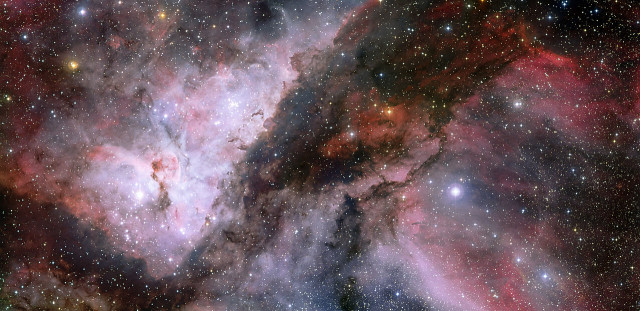
This spectacular panoramic view combines a new image of the field around the Wolf–Rayet star WR 22 in the Carina Nebula (right) with an earlier picture of the region around the unique star Eta Carinae in the heart of the nebula (left). The picture was created from images taken with the Wide Field Imager on the MPG/ESO 2.2-metre telescope at ESO’s La Silla Observatory in Chile. Image: ESO
Eta Carinae is rapidly using up its supply of nuclear fuel and will likely run out of it completely at some point within the next million years.
Once it does, it will go out in an outburst dramatic enough to be visible from Earth during the day according to some, and leave behind a black hole. The massive star could meet its end tomorrow or in a thousand years, or later. The timeline is difficult to predict.
The star’s exceptionally high mass is the reason why it is so unstable and uses its fuel so quickly. Many believe that stars like Eta Carinae will exhibit substantial loss of mass and become Wolf-Rayet stars before they go out as supernovae, if they can’t hold their mass to end their lives as hypernovae.
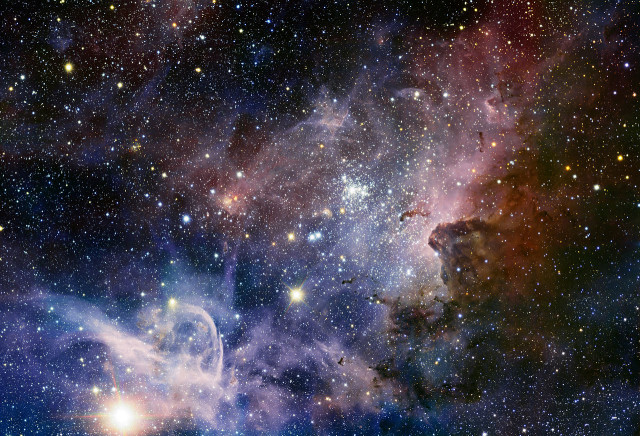
This broad panorama of the Carina Nebula, a region of massive star formation in the southern skies, was taken in infrared light using the HAWK-I camera on ESO’s Very Large Telescope. Many previously hidden features, scattered across a spectacular celestial landscape of gas, dust and young stars, have emerged. Some of these features have been annotated in Commons. Trumpler 16 (lower left) is an open cluster that contains the luminous, massive blue variable Eta Carinae, one of the brightest stars in the galaxy, possibly as much as 120 times the mass of the Sun, and emitting the light of 4,000,000 Suns. Eta Carinae is nearing the end of its life, and is surrounded by a huge nebula, cast off by numerous eruptions of the star over the last several centuries; it is expected to go supernova at any time. Trumpler 14 (in the centre) contains the huge double star HD 93129 A/B. The young O3 class star HD 93129 A is one of the brightest stars in the galaxy that is still on the main sequence, and with a luminosity equivalent to 3,000,000 Suns, is very nearly as bright as Eta Carinae, but this is not obvious in the photo due to obscuring nebulosities. Image: ESO/T. Preibisch
The star is located near the centre of Trumpler 16, one of the main star clusters found in Carina OB1 which in turn is one of the main stellar associations in the Carina Nebula. The star is suspected to have formed as the centre of mass of the molecular cloud in which Trumpler 16 was formed.
Eta Carinae was first catalogued by the English astronomer, physicist and mathematician Edmond Halley in 1677. At the time, it was a 4th magnitude star. It brightened considerably by 1730, and became one of the brightest stars in Carina constellation. The star then dimmed and reverted to its former magnitude by 1782, and did not start increasing in brightness again until 1820.
The Greek letter Eta (η) was assigned to the star by the French astronomer Nicolas Louis de Lacaille in the 18th century. Eta Carinae was a 2nd magnitude star by then. Lacaille was responsible for mapping all the stars in what was then the much larger constellation Argo Navis, consisting of the present-day constellations Carina, Puppis, and Vela.
The star is known as Tseen She (“Heaven’s Altar”) and Foramen in traditional Chinese astronomy, and also as “the Second Star of Sea and Mountain,” referring to an asterism it forms with the stars s Carinae, Lambda Centauri in Centaurus constellation and Lambda Muscae in Musca.
In April 1843, Eta Carinae brightened again and became the second brightest star in the sky, dimmer only than Sirius. This lasted about 20 years. It had an apparent magnitude of -0.8. Afterwards, it faded again and became invisible to the unaided eye by 1868, leaving behind what we now know as the Homunculus Nebula. During the outburst, Eta Carinae was second only to Sirius in brightness despite the vast difference in the stars’ distances to Earth. Sirius is only 8.6 light years away and Eta Carinae is approximately 7,500 light years distant.
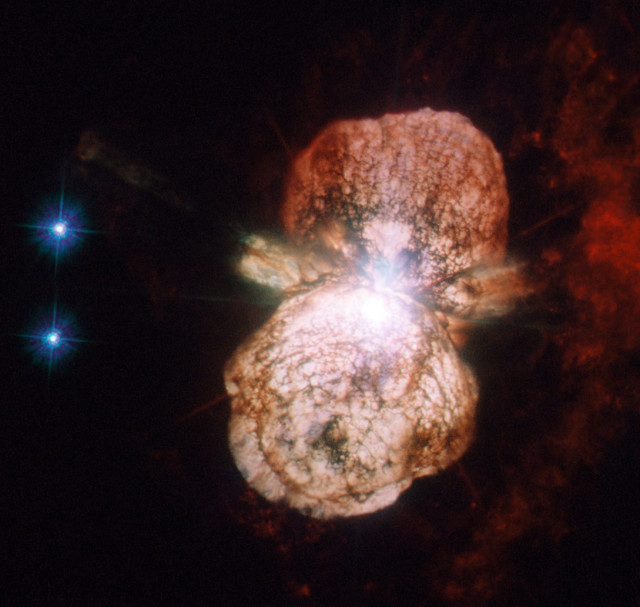
At the turn of the 19th century, the binary star system Eta Carinae was faint and undistinguished. In the first decades of the century, it became brighter and brighter, until, by April 1843, it was the second brightest star in the sky, outshone only by Sirius (which is almost a thousand times closer to Earth). In the years that followed, it gradually dimmed again and by the 20th century was totally invisible to the unaided eye. The star has continued to vary in brightness ever since, and while it is once again visible to the unaided eye on a dark night, it has never again come close to its peak of 1843. The larger of the two stars in the Eta Carinae system is a huge and unstable star that is nearing the end of its life, and the event that the 19th century astronomers observed was a supernova impostor. Scientists call these outbursts supernova impostor events, because they appear similar to supernovae but stop just short of destroying their star. Although 19th century astronomers did not have telescopes powerful enough to see the 1843 outburst in detail, its effects can be studied today. The huge clouds of matter thrown out a century and a half ago, known as the Homunculus Nebula, have been a regular target for Hubble since its launch in 1990. This image, taken with the Advanced Camera for Surveys High Resolution Channel is the most detailed yet, and shows how the material from the star was not thrown out in a uniform manner, but forms a huge dumbbell shape. Eta Carinae is not only interesting because of its past, but also because of its future. It is one of the closest stars to Earth that is likely to go out in a supernova in the relatively near future (though in astronomical timescales the “near future” could still be a million years away). When it does, expect an impressive view from Earth, far brighter still than its last outburst: SN 2006gy, the brightest supernova ever observed, came from a star of the same type.
This image consists of ultraviolet and visible light images from the High Resolution Channel of Hubble’s Advanced Camera for Surveys. The field of view is approximately 30 arcseconds across. Image: ESA/Hubble & NASA
Eta Carinae started to brighten again in the 1990s. In 1998 and 1999, the star’s brightness suddenly doubled. In 2007, the star had a visual magnitude of 5 and was once again visible to the unaided eye.
After the Great Eruption, some of the light from the star headed directly toward Earth, and in all other directions, but some of it also reflected off the nearby dust clouds and took a detour. This phenomenon is called a light echo. At least some of the echo of the event observed in 1843 reached us only recently. The supernova impostor event itself, of course, occurred about 7,500 years ago. The echoes were detected in 2011 using the U.S. National Optical Astronomy Observatory’s Blanco 4-meter telescope at the Cerro Tololo Inter-American Observatory.
When Eta Carinae meets its end, the intense radiation from the supernova event most likely won’t affect us directly because, at 7,500 light years, it will be nowhere nearly as intense by the time it reaches Earth. However, observers in southern latitudes will see quite a spectacle in the sky, as Eta Carinae is one of the most massive stars in the Milky Way and the supernova event will be a very bright one. If the event does cause us some damage, it will be to the upper atmosphere and the ozone layer. Satellites, spacecraft, and astronauts could be affected. The supernova will probably eject a gamma ray burst (GRB) from the polar areas of the star’s rotational axis, but as the star’s axis doesn’t point toward Earth, the gamma ray will probably not affect us.
Stars as massive as Eta Carinae are very rare, and galaxies the size of the Milky Way contain only about a few dozen of them. Stars that are over 120 solar masses exceed the Eddington limit, which means that the outward pressure of their radiation is nearly powerful enough to counteract gravity, i.e. their own gravity can barely hold in the star’s radiation and gas.
Eta Carinae’s supernova impostor event became a prototype for this kind of phenomenon. Other similar events have been seen in other galaxies in the last century, including SN 1961v in NGC 1058 in Perseus constellation and SN 2006jc in UGC 4904. Located at a distance of 77 million light years from Earth in the direction of the constellation Lynx, SN 2006jc produced an impostor event in 2004 and went out as a type Ib supernova two years later, on October 9, 2006.
Eta Carinae
Constellation: Carina
Stellar classification: BIae-0 / OI
Variable type: LBV (luminous blue variable) and binary
Coordinates: 10h 45m 03.591s (right ascension), -59°41’04.26” (declination)
Apparent magnitude: -0.8 to 7.9
Absolute magnitude: -7
Mass: 120 solar masses/30 solar masses
Radius: 240 solar radii/24 solar radii
Luminosity: 5 million solar luminosities/1 million solar luminosities
Temperature: 15,000 K/37,200 K
Designations: Eta Carinae, η Carinae, η Car, Foramen, Tseen She, 231 G. Carinae, HR 4210, CD−59°2620, HD 93308, SAO 238429, WDS 10451-5941, IRAS 10431-5925, GC 14799, CCDM J10451-5941
